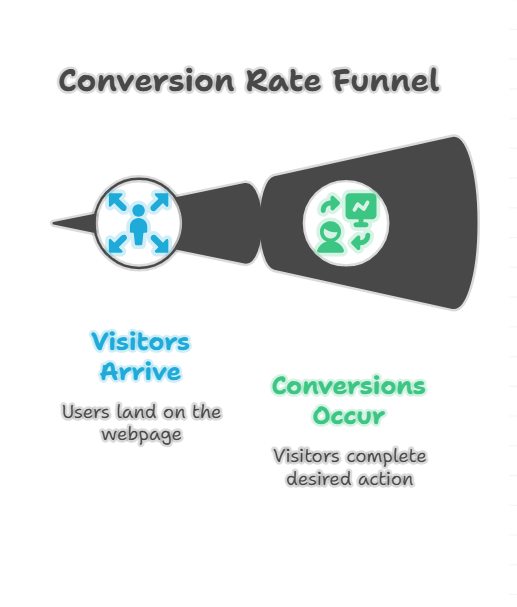Conversion rate is a crucial metric for any online business or marketing campaign. It represents the percentage of visitors who take a desired action on a website or landing page. Whether your goal is to make a sale, collect email addresses, or encourage users to download a resource, calculating the conversion rate gives you insight into how well your website or campaign is performing.
In this comprehensive guide, we will walk through everything you need to know about calculating conversion rate, why it matters, and how you can use it to improve your online business’s success.
What is Conversion Rate?

The conversion rate is the percentage of visitors who complete a desired action on your website or landing page. A “conversion” refers to a predefined goal, such as:
- Making a purchase (in e-commerce).
- Signing up for a newsletter.
- Filling out a contact form.
- Downloading a resource (like an e-book or a whitepaper).
Conversion rate is a key performance indicator (KPI) that helps you gauge the effectiveness of your website, marketing campaigns, and user experience.
Formula for Calculating Conversion Rate

The formula to calculate conversion rate is simple: Conversion Rate=(Number of ConversionsTotal Number of Visitors)×100\text{Conversion Rate} = \left( \frac{\text{Number of Conversions}}{\text{Total Number of Visitors}} \right) \times 100Conversion Rate=(Total Number of VisitorsNumber of Conversions)×100
Where:
- Number of Conversions is the total number of people who completed the desired action.
- Total Number of Visitors refers to the number of people who visited the webpage or landing page.
Step-by-Step Guide to Calculate Conversion Rate

- Determine Your Desired Action:
- First, identify the action you want visitors to take. For instance, if you’re running an e-commerce site, the desired action could be a purchase. If you have a blog, the action could be subscribing to your newsletter.
- Track the Number of Conversions:
- Using website analytics tools (like Google Analytics), track how many people have completed the action. For example, if your goal is to increase newsletter subscriptions, the number of conversions will be the number of users who signed up.
- Track the Total Number of Visitors:
- Track how many people visited the specific page or site during the same period. This can be done using the same analytics tools.
- Apply the Formula:
- Use the conversion rate formula to calculate the percentage.
Example 1: E-Commerce Site
Let’s say you have an e-commerce website. Over the past month, 50,000 visitors came to your site, and 2,000 of them made a purchase.
- Number of Conversions = 2,000 (purchases made)
- Total Visitors = 50,000
Conversion Rate=(2,00050,000)×100=4%\text{Conversion Rate} = \left( \frac{2,000}{50,000} \right) \times 100 = 4\%Conversion Rate=(50,0002,000)×100=4%
So, your conversion rate is 4%. This means 4% of visitors to your site completed a purchase.
Example 2: Landing Page for Lead Generation
If you’re running a lead generation campaign, and you have a dedicated landing page where users sign up for a free e-book, and you receive 1,500 visitors with 300 people signing up for the e-book:
- Number of Conversions = 300 (sign-ups)
- Total Visitors = 1,500
Conversion Rate=(3001,500)×100=20%\text{Conversion Rate} = \left( \frac{300}{1,500} \right) \times 100 = 20\%Conversion Rate=(1,500300)×100=20%
Your conversion rate is 20%, meaning 20% of visitors to your landing page converted into leads.
Why is Conversion Rate Important?

Conversion rate is one of the most important KPIs for understanding the success of a business’s digital marketing efforts. Here are a few reasons why calculating conversion rate is essential:
- Measure Campaign Effectiveness: The conversion rate helps you evaluate the effectiveness of your marketing campaigns, landing pages, and website design.
- Optimize Marketing Budget: Understanding your conversion rate can help you allocate marketing resources more effectively. For example, you can focus on the channels or campaigns that yield the best conversion rates.
- Customer Experience Insights: A low conversion rate might signal that something is wrong with the user experience. It could mean slow website loading times, confusing navigation, or unclear calls-to-action (CTAs).
- Improve ROI (Return on Investment): By optimizing for conversions, you can increase sales or leads without having to increase traffic, ultimately improving your ROI.
Factors That Affect Conversion Rate

Several factors can influence your website’s conversion rate. Here are some of the most common ones:
- Website Speed: A slow-loading website can lead to high bounce rates and lower conversions. Make sure your site loads in under 3 seconds.
- User Experience (UX): Poor navigation or a complicated checkout process can negatively impact conversion rates. Ensure that your website is user-friendly and intuitive.
- Mobile Optimization: A growing number of users access websites via mobile devices. If your site isn’t mobile-friendly, you may be losing conversions. Test your site on different screen sizes.
- Call-to-Action (CTA): A compelling and clear CTA is crucial to guiding visitors towards conversion. A CTA that is ambiguous or hard to find can hinder conversions.
- Content Relevance: If your content doesn’t meet the expectations or needs of your audience, conversions will drop. Make sure that the content and offers are relevant to the visitors coming to your site.
- Trust Signals: Including trust signals like customer testimonials, reviews, and secure payment icons can improve user confidence and increase conversions.
- A/B Testing: Regularly conducting A/B tests on landing pages, CTAs, and offers will help you identify what resonates best with your audience and optimize for better conversion rates.
Conversion Rate Optimization (CRO) Techniques
If you find that your conversion rate is lower than expected, there are several techniques you can implement to improve it:
- A/B Testing: Run A/B tests to compare different versions of your website or landing page. Test headlines, CTAs, design elements, and product descriptions to see what works best for your audience.
- Simplify the Conversion Process: Reduce the number of steps it takes for users to complete the desired action. For instance, streamline the checkout process or minimize form fields.
- Add Social Proof: Use customer reviews, testimonials, or trust badges to build credibility and trust, encouraging visitors to convert.
- Clear and Compelling CTA: Ensure your call-to-action is visible, clear, and communicates a sense of urgency. Use action-oriented words like “Get Started,” “Download Now,” or “Claim Your Offer.”
- Improve Site Speed: As mentioned earlier, slow websites lead to poor conversion rates. Tools like Google PageSpeed Insights can help identify performance issues and improve loading times.
- Retargeting: Retarget users who visited your site but didn’t convert with tailored ads to encourage them to return and complete the desired action.
Conclusion :
Calculating the conversion rate is a fundamental part of any online marketing strategy. It provides you with actionable insights into how well your website or campaign is performing and where improvements are needed. By understanding and optimizing for conversion rate, you can increase sales, leads, or any other desired action, ultimately boosting your business’s success.
Key Takeaways:
- The conversion rate is calculated by dividing the number of conversions by the number of visitors and multiplying by 100.
- Conversion rate optimization is crucial for improving the effectiveness of your digital marketing efforts.
- A combination of user experience enhancements, clear calls-to-action, and A/B testing can help improve conversion rates over time.





